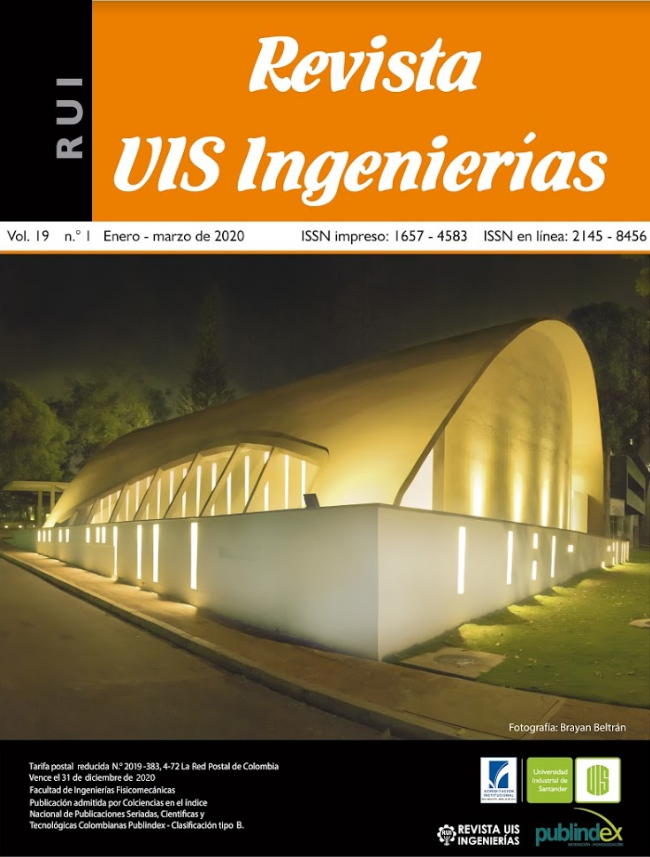Risk level due to the use of the basket in mora de Castilla (Rubus Glucus Benth) of Piedecuesta, Colombia
Published 2019-12-31
Keywords
- occupational risks,
- low back pain,
- agriculture,
- rubus,
- O.W.A.S.
How to Cite
Copyright (c) 2020 Revista UIS Ingenierías

This work is licensed under a Creative Commons Attribution-NoDerivatives 4.0 International License.
Abstract
This article associates the way of using the basket with the degree of pain in the collection of Mora de Castilla. A cross-sectional correlational study is presented, with the participation of four male workers. The real conditions of the task were analyzed in 256 positions using the O.W.A.S. It was found that 45.3% of the positions have a risk level of 2. The statistical association of the treatment with the level of risk was p = 0.709, for back p = 0.516, for arms p = 0.005 and for legs p <0, 05. It is concluded that there is no significant difference between the treatment and the level of risk of the task, which suggests that the way in which farmers use the basket does not influence an increase or decrease in postural risk in the collection task of Mora de Castilla. However, according to O.W.A.S. It is necessary to implement corrective actions in the near future. The way farmers use the basket does not influence an increase or decrease in postural risk in the task of collecting Mora de Castilla.
Downloads
References
[2] Cámara de Comercio de Bucaramanga, “Actividad Agrícola en Santander año 2015,” Bucaramanga, 2016. [En línea]. Disponible en: http://www.camaradirecta.com/temas/documentos%20pdf/informes%20de%20actualidad/2016/agropecuario_2015.pdf
[3] Ministerio de Agricultura y Desarrollo Rural, “Desarrollo de la fruticultura en Santander,” Bucaramanga, 2006. [En línea]. Disponible en: http://www.asohofrucol.com.co/archivos/biblioteca/biblioteca_114_Plan%20Nal%20frur-santander.pdf
[4] Sistema de Infirmación de Precios yAbastecimiento del Sector Agropecuario, “El cultivo de la mora de Castilla (Rubus glucus Benth) frutal de clima frío moderado, con propiedades curativas para la salud humana,” Cundinamarca, 2013. [En línea]. Disponible en: https://www.dane.gov.co/files/investigaciones/agropecuario/sipsa/insumos_factores_de_produccion_nov_2013.pdf
[5] A. Osborne et al., “Work-related musculoskeletal disorders among Irish farm operators,” Am. J. Ind. Med., vol. 56, no. 2, pp. 235–242, Feb. 2013, doi: 10.1002/ajim.22092.
[6] A. Thetkathuek, P. Meepradit, and T. Sa-ngiamsak, “A Cross-sectional Study of Musculoskeletal Symptoms and Risk Factors in Cambodian Fruit Farm Workers in Eastern Region, Thailand,” Saf. Health Work, vol. 9, no. 2, pp. 192–202, 2018, doi: 10.1016/j.shaw.2017.06.009.
[7] M. Młotek, Ł. Kuta, R. Stopa, and P. Komarnicki, “The Effect of Manual Harvesting of Fruit on the Health of Workers and the Quality of the Obtained Produce,” Procedia Manuf., vol. 3, pp. 1712–1719, 2015, doi: 10.1016/j.promfg.2015.07.494.
[8] C. Calisto and S. Kleisinger, “Ergonomics in orchard work - evaluation and possible improvements,” in 6th International Symposium on Fruit, Nut and Vegetable Production Engineering, 2001, pp. 675–679.
[9] E. G. Richardson, S. Fulmer, P. Jenkins, C. Mason, C. Bresee, and J. May, “Ergonomic Analysis of New York Apple Harvest Work Using a Posture-Activities-Tools-Handling (PATH) Work Sampling Approach,” J. Agric. Saf. Health, vol. 10, no. 3, pp. 163–176, 2004, doi: 10.13031/2013.16473.
[10] P. K. Pranav and T. Patel, “Impact of ergonomic intervention in manual orange harvester among the workers of hilly region in India,” Work, vol. 54, no. 1, pp. 179–187, May 2016, doi: 10.3233/WOR-162285.
[11] ESENER-2, “Risk factors present in the establishment: Tiring or painful positions,including sitting for long periods,” osha europa, 2014. [En linea]. Disponible en: https://osha.europa.eu/en/surveys-and-statistics-osh/esener/2014?locale=EN&dataSource=esener04&media=png&width=740&question=Q200_1&plot=crossCountry&countryGroup=linear&subset=Sectorgrp&subsetValue=All&country=NO&countryB=SK
[12] I. L. Nunes, “Introduction to musculoskeletal disorders - OSHWiki,” oshwiki, 2017. .[En linea]. Disponible en: https://oshwiki.eu/wiki/Introduction_to_musculoskeletal_disorders
[13] F. Maradei, C. P. Ardila-Jaimes, And S. J. Sanabria-Sarmiento, “Síntomas Musculoesqueléticos En Las Actividades De Cosecha De Mora De Castilla De Piedecuesta, Colombia,” Hacia La Promoción La Salud, Vol. 24, No. 2, Pp. 91–106, 2019, doi: 10.17151/Hpsal.2019.24.2.8.
[14] O. Karhu, P. Kansi, and I. Kuorinka, “Correcting working postures in industry: A practical method for analysis,” Appl. Ergon., vol. 8, no. 4, pp. 199–201, 1977, doi: 10.1016/0003-6870(77)90164-8.
[15] P. Callea et al., “Occupational illnesses related to physical strains in apple harvesting,” Ann. Agric. Environ. Med., vol. 21, no. 2, pp. 407–411, 2014, doi:10.5604/1232-1966.1108614.
[16] G. Earle-Richardson, P. Jenkins, S. Fulmer, C. Mason, P. Burdick, and J. May, “An ergonomic intervention to reduce back strain among apple harvest workers in New York State,” Appl. Ergon., vol. 36, no. 3, pp. 327–334, 2005, doi: 10.1016/j.apergo.2004.12.003.
[17] D. Kee, “Gender differences in rankings of joint motion stressfulness based on psychophysical scaling,” Int. J. Ind. Ergon., vol. 35, no. 5, pp. 461–469, 2005, doi: 10.1016/j.ergon.2004.11.001.

